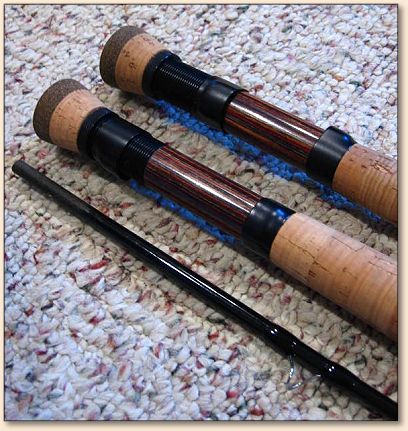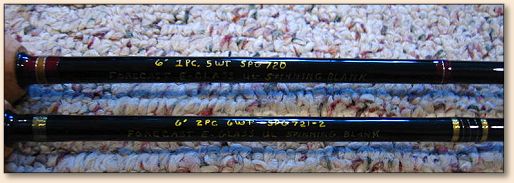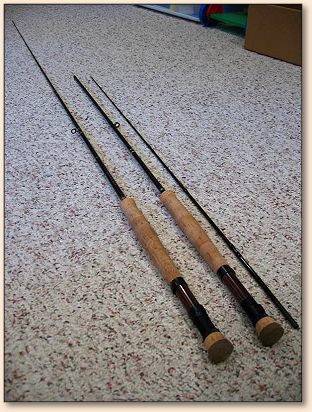|
If you have been fortunate enough to attend one of the FAOL
Fish-Ins, you know that a big part of these gatherings is
casting a wide array of different fly rods. Everyone seems
to pack a small arsenal of rods -- way more than they could
possibly fish in the time they are at the event. All sorts
of rods are brought - anything from graphite to bamboo, and
from to banty rods to spey rods. While a good number of these
rods are not fished, they are all put to good use. After all,
who doesn't like casting and comparing new or different fly rods?
It's just one of the many beauties of these gatherings.
This year's Michigan Fish-In was no exception. Many fine
casting instruments were circulated amongst the eager masses.
Trying to do my part, I brought up a number of rods that I
thought others might enjoy casting. I was particularly eager
to show off two rods that I recently built. The rods were built
out of short fiberglass blanks, each six feet in length, but
they weren't typical fly rod blanks. Instead, they were built
out of ultralight spinning blanks, manufactured by Batson
Enterprises.
Before I get too far into this article, I want to make one thing
clear. I did not come up with the idea of using these blanks for
building fly rods. I first heard about them while visiting the
Fiberglass
Flyrodders Forum. Messages about these blanks have been
posted on other boards as well, including rodbuildingforum.com,
rodbuilding.org, and the FAOL Rod Building and Restoration board.
A number of rod builders on the Fiberglass Forum have experimented
with and written about these blanks. The person probably most
responsible for bringing these blanks to the attention of those
on the forums is Luis Perez, who goes by the handles Loudog99
or Loudog on other forums, and by L-dog here on FAOL. Lou is
an amateur rod builder who is coming to be known on most of these
boards for his beautiful wraps, grips, and reel seats. He was drawn
to experiment with these blanks because of the work of others who
talked about using ultralight spinning rods for casting flylines
and ultralight spinning blanks for building fly rods.

In my communications with Lou about these blanks prior to writing
this article, he commented, "I basically wanted a short rod to
use from my kayak for bass and panfish, that would load easily
at short distances and find that most graphite blanks under 6.5'
are too stiff. The blanks are priced very reasonably and being
E-glass I thought they might fit the bill. I am always looking
for bang-for-the-buck components and these blanks deliver. Also,
being that they fish best with 5wt and 6wt lines, they allow me
to cast a variety of flies and because they are glass, they still
allow the fish to show off. Lastly, I can build a very nice rod
with these blanks for anywhere from $75 to $100 using top components.
You cannot buy anything like this from any of the top rod companies."
While reading the messages about these blanks on the Fiberglass
Forum, several things caught my attention. I was intrigued by
the idea of building a shorter length rod that would cast a heavier
weight flyline. I wanted a short rod with some muscle that I could
use on a couple of local Michigan trout streams that, while small in
size, have been known to harbor some very respectable sized trout
(upwards of 16-20 inches in length). I wanted a short rod that could
cast larger hopper and attractor patterns and had the strength to turn
larger fish or lift them out of the submerged lumber that litters the
banks and pools of these particular streams. These blanks seemed to fit
that bill nicely, ranging in line weights from 5 to 7. It is difficult
to find graphite blanks less than 7 feet in length that aren't a 4 weight
or smaller. In the days before graphite, higher line weights were common
in these lengths, especially in fiberglass rods by Fenwick, Phillipson,
Heddon, and others. And of course, the other big attraction to these
blanks was the cost. I will talk about this more later, but the blanks
for the two rods that I built cost only $13 and $5 a piece!
Batson Enterprises builds a number of one piece E-glass UL spinning blanks
under the Forecast model name, ranging from 5 feet to 7 feet in length.
Since they are fiberglass, they all have more moderate actions than similar
graphite UL spinning rod blanks. However, not all of these blanks appear
well suited for building fly rods. The models most widely acclaimed for
use in building fly rods include the 5 foot one piece SPG601 (as a 6
weight rod), the 6 foot one piece SPG720 (as a 4/5/6 wt rod), the 6 foot
one or two piece SPG721 (as a 6/7 wt rod), and the 6-1/2 foot one piece
SPG780 (as a 3/4 wt rod). The rods I built were the SPG720 and the SPG721-2.

Batson no longer makes or sells the two piece SPG721-2, but they are
still widely available from various online retailers. The two piece
blank I bought has a butt-over-tip ferrule. While the one piece rods
are very smooth, two piece rods are certainly easier to transport.
If you are up for a bit of a fun challenge, buy a couple of the
blanks, and convert one of them into a two piece rod by cutting it
yourself and installing a spigot ferrule. The distributors of these
blanks that I know of include schneiderrods.com, fishsticks4u.com,
cotesflyshop.biz, and rod-blanks.com. You can also try your local
fishing and sporting goods store. I found my SPG720 blank at a
small local sporting goods store in Hastings, Michigan.
After purchasing the blanks and guides, I decided to install Fenwick
style cork grips, which happen to be the cheapest prefinished cork
grip Cabelas sells at a price of only $6. I added AJ5-B reel seats
that I bought on sale for $5 each and a 1" fighting butt. I installed
fighting butts on the rods partly as wishful thinking, but also as a
means of keeping the reel out of the dirt and mud. In all, I spent
between $20-$35 per finished rod! That's it!
Now I know you're probably thinking, "It must not be worth much if
it doesn't cost very much. How do they cast?" Well if you like
fast action rods, you may not like these blanks. The 720 has a
full-flex or medium slow action, while the 721-2 has a stiffer
mid-flex or medium action. While I like both rods, I have to say
that the 720 is probably one of the neatest rods I have ever cast.
It casts either a 4, 5, or 6 wt line well. I personally like it
best with a WF5. With a WF5 line (I don't use anything fancy on
it, just a cheap line from Cabelas), the rod starts loading with
10-15 feet of line and proceeds to shoot line nicely all the way
to 50-60 feet. I would consider myself to be an average caster,
and I can reach over 60 feet easily with just a light double haul.
I have witnessed good distance casters go farther with it.

The thing I really appreciate about the 720 is the feel of the rod
while you are casting. You can really feel the rod and line working
together, loading and unloading. The 721-2 is also very nice, but
it is a bit stiffer, and I think you lose some of the feeling of
connection that the 720 has. I'm pretty sure the folks at the
Fish-In would agree with my positive impressions of the rods.
We casted them off the dock and on the lawn at Gates Lodge,
drawing quite a crowd and a lot of positive remarks.
I'd really like to try out the 780 for light trout and bluegill
fishing because I have heard some really good things about it as
well. And as long as I have the podium, I might as well put in
a request to Batson. Several people from the Fiberglass Forum
have expressed interest in two piece versions of the 720 and a
780, which would make them easier to transport, and eliminate
the need to install a spigot ferrule. Pretty please!

If you would like to try building some really fun fly rods, rods
that give you way more enjoyment than what you paid for, then I
urge you to give Batson's Forecast E-glass UL spinning blanks a
try. In fact, try building one this winter and then bring it to
the 2008 Michigan Fish-In! You never know what kind of fun
fishing challenges we could come up with using these rods! ~ Jim Flamming
|




